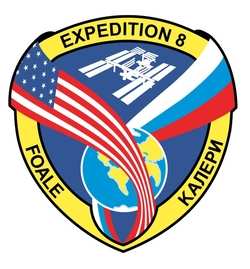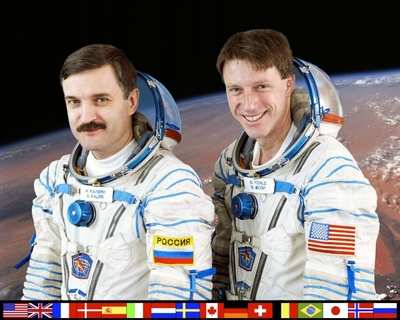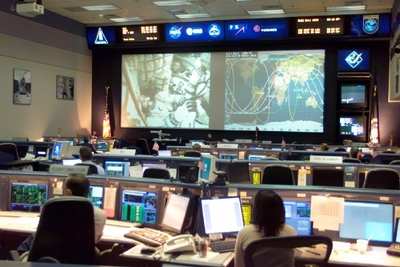Tue, Dec 09, 2003
ISS Status Report #03-62, 4 p.m. CST, Friday, Dec. 5, 2003
 Expedition 8 Commander and NASA ISS
Science Officer Mike Foale and Flight Engineer Alexander Kaleri
Friday wrapped up a busy week aboard the International Space
Station. ISS activities included scientific experiments ranging
from behavior of plasma dust subjected to radio waves in a vacuum
to investigation of stresses on the feet and legs during
spaceflight.
Expedition 8 Commander and NASA ISS
Science Officer Mike Foale and Flight Engineer Alexander Kaleri
Friday wrapped up a busy week aboard the International Space
Station. ISS activities included scientific experiments ranging
from behavior of plasma dust subjected to radio waves in a vacuum
to investigation of stresses on the feet and legs during
spaceflight.
Kaleri completed the first run of the Russian Plasma Crystal-3
experiment on Thursday, after preparations on Monday and experiment
setup on Tuesday. The largely automated experiment studies
crystallization of plasma dust subjected to high-frequency radio
waves in a vacuum chamber.
On Tuesday, Foale spent much of his day in instrumented biking
tights for the Foot/Ground Reaction Forces During Spaceflight
(FOOT) experiment. The Lower Extremity Monitoring Suit, the cycling
tights outfitted with 20 sensors, measured forces on Foale’s
feet and joints and muscle activity while he went about his
scheduled activities. Investigators believe the experiment will
provide additional information on reasons for bone and muscle loss
by people in space. That knowledge could lead to better ways to
minimize such problems.
Also completed during the week was spacesuit battery maintenance
– discharging and recharging the batteries, reloading of
laptop computers, continued participation by crewmembers in the
Renal Stone experiment, regular maintenance and standard crew
exercise sessions.

On Thursday crewmembers did an inspection of the Treadmill
Vibration Isolation System, the treadmill in the Zvezda Service
Module mounted on a sophisticated system that minimizes
transmissions of vibrations created by exercising crewmembers. Both
also ran on the treadmill with its Vibration Isolation and
Stabilization turned off. Instruments they had set up earlier in
Zvezda and the Unity node monitored vibrations produced.
Crewmembers have approval to use the TVIS in a modified
configuration.
They are scheduled to spend at least four hours on Tuesday and
four hours on Wednesday removing the TVIS from its housing for
inspection and possible repair of a stabilizing gyroscope. Today
Foale talked with TVIS experts at Johnson Space Center in
preparation for next week's work with the treadmill.
The TVIS and several other exercise devices aboard the ISS are
used about 2½ hours each day by each crewmember. The
exercise is designed to mitigate some of those negative effects of
long-term spaceflight.

On Tuesday Foale and Kaleri talked with CBS' "Osgood Files" and
with reporters from CBS Radio. Foale spent more than 15 minutes on
Thursday chatting with Sir David Frost for the BBC's "Breakfast
with Frost" program.
More News
“This vote sends an undeniable message to Air Transat management: We are unified, resolute, and have earned a contract that reflects today’s industry standards, not the>[...]
Aero Linx: Beech Aero Club The Beech Aero Club (BAC) is the international type club for owners and pilots of the Beech Musketeer aircraft and its derivatives, the Sport, Super, Sun>[...]
While Landing In The River, The Extended Landing Gear Contacted The Water And The Airplane Nosed Over, Resulting In Substantial Damage Analysis: The pilot of the amphibious airplan>[...]
From 2022 (YouTube Edition): Carrying the Legacy of The B-29 For Generations to Come We had a chance to chat with the Executive Director of B-29 Doc, Josh Wells, during their stop >[...]
Also: Cosmonaut Kicked Out, Airbus Scales Back, AF Silver Star, Russian A-60 Clobbered A Samaritan’s Purse humanitarian flight was hijacked on Tuesday, December 2, while atte>[...]
 Aero-News: Quote of the Day (12.07.25)
Aero-News: Quote of the Day (12.07.25) ANN's Daily Aero-Linx (12.07.25)
ANN's Daily Aero-Linx (12.07.25) NTSB Final Report: Lafferty Jack Sea Rey
NTSB Final Report: Lafferty Jack Sea Rey Classic Aero-TV: The B29 SuperFortress Doc - History in Flight
Classic Aero-TV: The B29 SuperFortress Doc - History in Flight Airborne 12.08.25: Samaritans Purse Hijack, FAA Med Relief, China Rocket Fail
Airborne 12.08.25: Samaritans Purse Hijack, FAA Med Relief, China Rocket Fail





